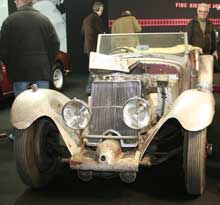In the middle ages, the word “squire” denoted a knight in training. More latterly it has meant a village leader or the dominant landowner. In the case of this car, it was simply the surname of the maker.
Adrian Squire (1910-1940) was just 21 when he decided to build his own motor car. He founded Squire Motors, Ltd., and set about designing a road-going Grand Prix car. Into a chassis of his own conception he put a 100-bhp Anzani twin-cam engine, clothed in a coachbuilt body. Squires are said to have had exceptional top speed and braking. Only about ten were built during 1935 and 1936. The still-young Mr. Squire was killed in a bombing raid during 1940 while working at the Bristol Aeroplane Company.
This Squire burst onto the scene as a much-vaunted barn-find at this year’s Rétromobile show in Paris. Offered by Fiskens of London, purveyors of fine historic automobiles, it reportedly lay dormant for 30 years before recent exhumation.
The 1,500-cc Anzani engine is force-fed by a Roots-type supercharger, and the car’s legendary stopping power is apparent in the size of the brakes, which are equipped with magnesium-alloy finned drums. The gearbox is a Wilson pre-selector unit, and the wood dashboard is instrumented with a clock, 120-mph speedometer, two oil gauges (the purpose of which is indeterminate – one reads 0-160, the other 0-1000), a combination vacuum-pressure gauge (for the supercharger), ammeter, temperature and a 6,000-rpm tachometer.
There’s been a lot of speculation about this car on one of the more influential auto blogs, in particular regarding the provenance of the barn-find detritus. We can report with authority that the straw, while authentic, is of a modern replacement variety, and the egg in the rear seat is supplied fresh daily – the yolk is on us…
A steady stream of onlookers paid homage to the Squire during the show, admiring its handsome aluminum body by John Charles (Ranalah) Ltd. and vintage India rubber tires.

